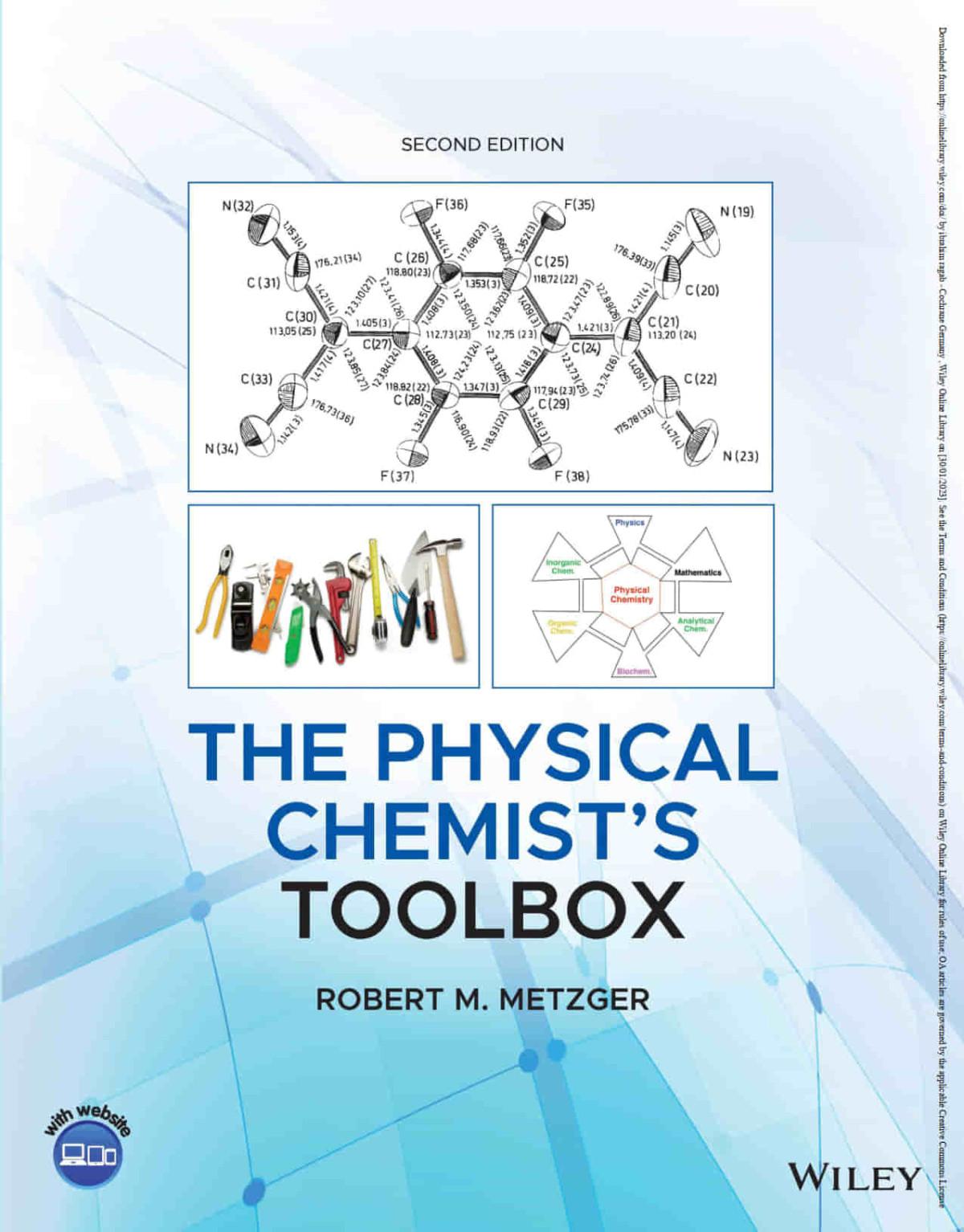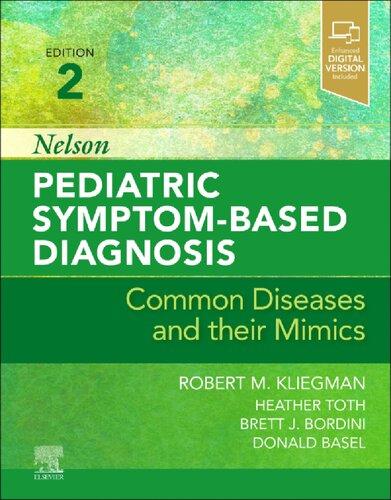ThePhysicalChemist’sToolbox
SecondEdition
RobertM.Metzger
DepartmentofChemistryandBiochemistry
TheUniversityofAlabama TuscaloosaandBirmingham,Alabama,USA
Contents
Foreword xvii
PrefaceandPhilosophy xix
AbouttheCompanionWebsite xxiii
1FundamentalParticles,FundamentalForces,andMathematicalTools 1
1.0Introduction 1
1.1FundamentalForces,ElementaryParticles,Nuclei,andAtoms 2
1.2ForceOne:Gravitation 16
1.3ForceThree:WeakForce 17
1.4ForceFour:StrongForce 17
1.5ReviewofMathematicalConcepts 24
1.5.1MathematicsandStatistics 24
1.5.2Functions,Equations,andFunctionals 24
1.5.3Quadratic,Cubic,andQuarticEquations 24
1.5.4PartialDerivatives 27
1.5.5Jacobians 30
1.5.6Lineintegral 30
1.5.7TheGauss–Green–StokesTheorem 30
1.5.8Techniquesofintegration 31
1.5.9DifferentialForms 33
1.5.10InfiniteSeries 33
1.5.11SumandIntegralKillers:TheKroneckerDeltaandtheDiracDeltaFunction 34
1.5.12OrdinaryDifferentialEquations(ODEs) 35
1.5.13TheLagrangeMethodofUndeterminedMultipliers 37
1.5.14PartialDifferentialEquations(PDEs) 38
1.6Mechanics,Vectors,Tensors,andDeterminants 39
1.6.1ForcesandLinearMomentum 39
1.6.2DimensionalAnalysis 39
1.6.3UnitSystems 39
1.6.4Vectors 41
1.6.5Determinants 42
1.6.6Matrices 44
1.6.7Tensors 45
1.6.8SimilarityTransformations 45
1.6.9Eigenvalue-EigenvectorProblem 46
1.6.10PlanarRotations 47
1.6.11EulerianRotations 48
1.6.12CovariantandContravariantVectorsandTensors 49
1.6.13Covariant 49
1.6.14MomentofInertiaandAngularMomentum 50
1.6.15DerivativeOperators: “SkiSlopes,”“Hernias,” and “Curls” 51
1.6.16Gradient 52
1.6.17Divergence 52
1.6.18Curl 52
1.6.19Gauss–Green–StokesTheorem 53
1.6.20Combinatorics 54
1.7Hooke’sLaw,One-dimensionalChain,DispersionRelations,andStress–StrainTensors 55
1.7.1LongitudinalMechanicalWavesSubjectedtoHooke’sLaw 57
1.7.2LongitudinalElasticWavesina1DArrayofEqualMassesandSprings 57
1.7.3One-dimensionalChainwithTwoKindsofAtoms:ABandGapAppears 59
1.7.4StressandStrainTensors 61
1.8Lagrange’sFunctionandHamilton’sFunction 62
1.9ForceTwo:Electromagnetism 63
1.9.1Coulomb’sLawandAmpère’sLaw 63
1.9.2MaterialMediaandTheirReactiontoExternalFields 65
1.9.3Maxwell’sEquations 66
1.9.4ScalarandVectorPotentials 70
1.9.5PolarizationofElectromagneticWaves 71
1.9.6Multipoles 72
1.9.7ElectricDipoleMoments 73
1.9.8ElectricMultipoleMoments,PolarizabilitiesandHyperpolarizabilities 73
1.10TheSizeofFundamentalParticlesandthePhysicalMeaningofQuantumNumbers 74
1.11SpecialRelativity 75
1.12FeynmanDiagrams 79
1.13GeneralRelativity,GravityasaCurvatureofSpace-TimeandtheSizeoftheUniverse 80
1.14ElementsofOptics 83
1.14.1JonesVector 88
1.14.2AnisotropicIndicesofRefraction 88
1.14.3Mirrors 89
1.14.4PrismsandGratings 92
1.15Transforms 94
1.15.1ConvolutionTheorem 97
1.15.2LaplaceTransforms 98
1.15.3WaveletTransform 100
1.16ContourIntegrationandKramers–KronigRelations 100
1.17ErrorAnalysis 102
1.17.1Errors 102
1.17.2PropagationofErrors 102
1.17.3GaussianNormalErrorProbabilityFunction 103
1.17.4BinomialDistribution 104
1.17.5PoissonDistribution 104
1.17.6LeastSquaresorLinearRegressionAnalysis 104
1.18Statistics 105
1.19GeneralReferences 107 References 137 End-of-ChapterProblems 138
2QuantumMechanics 147
2.0Introduction 147
2.1QuantumPostulates 147
2.1.1Bras,Kets,andHermitianOperators 151
2.2QuantumMechanicsoftheFreeElectron 154
2.3TheParticleinaBox 155
2.3.1TunnelingorBarrierPenetrationorScatteringinOneDimension 157
2.3.2RadioactiveDecay 160
4.5.5ElectronicExcitation 341
4.5.6EinsteinandDebyeTheoriesoftheLow-temperatureHeatCapacityofSolids[4.2] 342
4.5.7DebyeTheoryoftheHeatCapacityofSolids 342
4.6Black-BoxRadiation,andtheBirthofQuantumMechanics 343
4.7ElectronicHeatCapacity:Drudevs.Fermi–Dirac 346
4.8MagneticSusceptibilities 349
4.8.1GeneralPhenomenology 349
4.8.2DiluteEnsembleofParamagneticIons 350
4.8.3Diamagnetism 352
4.8.4Ferromagnetism 355
4.9ElectricSusceptibilities 356
4.10UniversalTheoryofCriticalPhenomena 360 References 360 End-of-ChapterProblems 361
5Kinetics,Equilibria,andElectrochemistry 363
5.0Introduction 363
5.1Energetics,ReactionCoordinate,TransitionStates,Intermediates,andCatalysis 363
5.2ClassificationofReactionTypes 367
5.3First-OrderandUnimolecularReactions 368
5.3.1Carbon-14Dating 368
5.4Second-Order(Unmixed)andUnmixedBimolecularReactions 369
5.5Second-Order(Mixed)andMixedBimolecularReactions 369
5.6Third-Order(Unmixed)andUnmixedTermolecularReactions 370
5.7ReversibleReactions 370
5.8ConsecutiveReactions 371
5.9TheSteady-StateApproximationandtheRate-DeterminingStep 372
5.10ApproximationMethods:theMichaelis–MentenEquation 372
5.11ChainReactions.TheReactionofHydrogenandBromineatHighTemperature 375
5.12UsingLaplaceTransformstoSolveKineticsEquations 377
5.13ReactionRateTheoriesandEnergySurfaces 378
5.14MarcusTheoryofElectronTransfer 380
5.15EquilibriainAqueousSolution:pH 383
5.16EquilibriainNonaqueousSolvents 391
5.17LewisAcidsandLewisBases 392
5.18Electrochemistry:ElectrodePotentialsandtheNernstEquation 393
5.19Gouy–ChapmanDouble-LayerTheory 405
5.20Nernst–PlanckandCottrellEquations 406 FurtherReading 409 References 409 End-of-ChapterProblems 410
6Symmetry 411
6.0Symmetry 411
6.1SymmetryinCrystals 411
6.2SymmetryOperationsandPointGroups 412
6.3GroupTheoryandCharacterTables 418
6.4BravaisLattices 427
6.5The32CrystallographicPointGroups 432
6.6The17PlaneGroups 433
6.7The230CrystallographicSpaceGroups 434
6.8ListingofElements,SimpleCompounds,andTheirCrystalStructures 443
6.9TheWigner–SeitzCell 455
6.10ReciprocalLattice 456
6.11Symmetryof2DSurfaces 458
6.12DescentofSymmetry 459
6.13CovariantandContravariantTransformations 459
6.13.1Covariant 459
6.13.2Contravariant 460
6.13.3FourbyFour 461
6.13.4Generationof230SpaceGroupsUsing4by4Matrices 462
6.14ExampleofDescentofSymmetry:VO2 462
References 466
7SolidStatePhysics 469
7.0Introduction 469
7.1ElectricalResistance,HallEffect,DrudeModel,Tunneling,andtheLandauerFormula 469
7.2Fermi–DiracStatisticsforElectronGas:SommerfeldModel 479
7.3X-rayDiffraction 484
7.4QuantumNumbersinaMacroscopicSolid:BlochWaves 487
7.5BlochWavesinOneDimensionandDispersionRelations 488
7.6BandStructures 490
7.7TheoreticalMethodsforComputingWavefunctionsinSolids 495
7.7.1 TheTight-BindingMethod 495
7.7.2CellularMethod 497
7.7.3BandStructurefortheMuffin-tinPotential 498
7.7.4AugmentedPlaneWaves(APW) 498
7.7.5OrthogonalizedPlaneWaves(OPW) 498
7.7.6HubbardHamiltonian 498
7.8MixedValenceandOne-DimensionalInstabilities 498
7.9DefectsandMobileExcitationsinSolidsandMolecules 500
7.10Superconductivity 501
7.11LatticeEnergies:Madelung,Repulsion,Dispersion,Dipole–dipole,andOthers 505 References 515
8ElectricalCircuits,Amplifiers,andComputers 519
8.0Introduction 519
8.1ElectricalComponents 519
8.2SimpleCircuitswithNoRectificationorAmplification 521
8.2.1Resistors 522
8.2.2Capacitance 522
8.2.3Capacitors 522
8.2.4Inductance 523
8.2.5Inductors 523
8.2.6Kirchhoff ’sRulesforCircuits 523
8.2.7SeriesRLCCircuit 524
8.3VacuumTubeDiode 528
8.4VacuumTubeTriode 530
8.5ConductioninPureandDopedSiandGe 533
8.6RectificationinpnJunctionDiodesorRectifiers 536
8.7pnpandnpnTransistors 540
8.8Small-SignalTheoryforTransistors 546
8.9Large-SignalBehaviorofJunctionTransistors 549
8.10UnipolarorField-EffectTransistors(FET) 550
8.11JFETs 554
8.12OperationalAmplifiers 554
8.13HistoricalIntroductiontoComputers 557
8.14ElementaryDigitalConcepts 558
8.15ComputerArchitecture 560
8.16Compilers 561
8.17SimpleProgramming 562
8.18CommunicatingwithaComputerOperatingSystemCommands 562 References 574 End-of-ChapterProblems 575
9Sources,Sensors,andDetectionMethods 577
9.0Introduction 577
9.1CosmicRays 577
9.2Source:IsotopesandFissionEnergySources 578
9.3Source:SolarEnergy 583
9.4Source:Earth-BasedNuclearFusion 588
9.5Source:PhotovoltaicCells 589
9.6X-rays 592
9.7CherenkovandSynchrotronRadiation,Bremsstrahlung 597
9.8ConventionalLightSources 597
9.9MicrowaveSources 598
9.10MasersandLasers 599
9.11Lightning 606
9.12St.ElmoFire 606
9.13AuroraBorealis 607
9.14Fireflies 607
9.15ArcsandSparks 607
9.16Flames 607
9.17Light-EmittingDiodes:Inorganic,Organic,andPolymeric 608
9.18ChemicalExplosivesandHigh-EnergyCompounds 609
9.19StorageBatteriesandElectrochemicalCells 610
9.19.1PracticalCellsandBatteries 613
9.20GenerationofHighVoltages 615
9.21TimeSensors 615
9.22MassSensors 615
9.22.1Two-PanBalances 615
9.22.2MagneticallyDampedOne-PanBalances 616
9.22.3Load-CellBalances 616
9.22.4Force-CoilAnalyticalBalances 616
9.22.5ThermogravimetricAnalyzer(TGA) 616
9.22.6QuartzCrystalMicrobalance 617
9.23TemperatureSensors 617
9.23.1LiquidinGlassThermometers 617
9.23.2PlatinumResistanceThermometer 617
9.23.3Thermistors 618
9.23.4Bolometers 618
9.23.5QuartzCrystalThermometer 620
9.23.6Pyrometers 620
9.24PressureSensors 620
9.24.1MercuryManometer 621
9.25HeatCapacities 622
9.26PhotographicPlatesandFilms 623
9.27WilsonCloudChamberandGlaserH2 BubbleChamber 624
9.28ScintillationCounter 624
9.29Geiger–MüllerCounter 624
9.30ProportionalCounters 624
9.31SparkChamber 624
9.32Photomultipliers 625
9.33X-rayAreaDetectors(ArrayDetectors) 625
9.34X-rayandInfraredFluoroscopyandImageIntensifiers 625
9.35DirectSemiconductorDetectors 625
9.36Charge-CoupledDevices 626
9.37PhotoelectricCells 626
9.38Interferometers 627
9.39SuperconductingQuantumInterferenceDeviceMagnetometers 628
9.40AbsorptionWavemeter 630
9.41Magnetometers 630
9.42VoltageSensors 631
9.43SlitsandBandwidth 632
9.44Noise 632
9.45Phase-SensitiveDetectionorLock-inAmplifiers 633
9.46HeterodyneDetection 633
9.47DerivativeDetection 634 References 634
10Instruments 635
10.0Introduction 635
10.1PhysicalSeparations:FractionalCrystallizationandDistillation 635
10.2Chromatography 637
10.3BiochemicalSynthesizersandPolymeraseChainReaction 639
10.4ElementalAnalysis 639
10.5MassSpectrometry 640
10.5.1Application(DevelopedbyC.Cassady):AnalysisofPeptidesbyMALDI/TOF-MS 643
10.5.2Application:IonizationandElectronAffinity 646
10.5.3CombinationInstruments 648
10.6OpticalandElectronMicroscopy 649
10.7ScannedProbeMicroscopies:STM,AFM,MFM,andLFM 651
10.8X-rayDiffractionofOrderedCrystals,Liquids,andDisorderedSolids 656
10.8.1X-rayScatteringandDiffractionIntensities 659
10.8.2TheElectronDensityFunctionandthe “PhaseProblem” 661
10.8.3DirectMethods 661
10.8.4PattersonandSymmetrySuperpositionMethods 662
10.8.5Least-SquaresRefinement 662
10.8.6ProteinCrystallography 663
10.8.7Liquids,Gases,andDisorderedSolids 664
10.8.8Small-AngleScattering 665
10.8.9DiffuseX-rayScattering 665
10.8.10NeutronDiffraction 666
10.8.11EXAFSandXANES 666
10.9Spectroscopy 667
10.10Visible–Ultraviolet(V–UV)Spectroscopy 667
10.10.1PolarizationofV–UVAbsorption 668
10.10.2Application:SpecularReflectionbyCrystalFaces 668
10.10.3OpticalConductivity 671
10.10.4VacuumUltravioletSpectroscopy 671
10.10.5Application:FirstExcitedStateofLinearPolyenes 671
10.10.6Application:Solvatochromism 671
10.11AtomicAbsorption,AtomicEmission,andAtomicFluorescenceSpectroscopies 672
10.12InfraredandNear-InfraredSpectroscopy 673
10.12.1FT-IRAdvantages 675
10.13RamanSpectroscopy 677
10.14InelasticElectronTunnelingSpectroscopy 679
10.15FluorescenceSpectroscopy 682
10.16MicrowaveSpectroscopy 683
10.17SurfacePlasmonResonance 684
10.18X-rayPhotoelectronSpectroscopy(XPS)andAugerElectronSpectroscopy(AES) 684
10.19MagneticMeasurements 687
10.20MagneticResonance 696
10.20.1TheFamilyofMagneticResonanceTechniques 696
10.20.2NuclearMagneticResonance(NMR) 699
10.20.3ElectronParamagneticResonance(EPR)Spectrometer 699
10.20.4TheBlochEquationsforMagneticResonance 701
10.20.5SlowPassageorEquilibriumorSteady-StateSolution 703
10.20.6SmallMagneticField:Measurementof T2 705
10.20.7Measurementof T2 705
10.20.8Measurementof T1 706
10.20.9RapidPassage 706
10.20.10FreeInductionDecay 707
10.20.11Spin-EchoNMR 708
10.20.12SelectiveSaturation 708
10.20.13NMRSpectrumofEthanol 709
10.20.14ChemicalShiftsinNMR 709
10.20.15MultipletsinNMR 710
10.20.16ParamagnetismKillstheNMRSpectrumbyBroadening 711
10.20.17MagnitudeofRelaxationTimes 711
10.20.18NMRinSolids 712
10.20.19Magic-AngleSpinning 712
10.20.20Multiple-PulseNarrowing 712
10.20.212DNMR 712
10.20.22DerivativeDetectionofEPRTransition 713
10.20.23StableFreeRadicals 714
10.20.24 g-Tensor 714
10.20.25Fine-StructureSplittingsinESRSpectraofTripletStates 716
10.20.26SpinLabeling 716
10.20.27NuclearResonanceinParamagneticSystems:KnightShift 717
10.20.28OverhauserEffect 717
10.20.29Electron–NucleusDoubleResonance(ENDOR)Spectroscopy 718
10.20.30OpticallyDetectedMagneticResonance(ODMR) 718
10.20.31NuclearQuadrupoleResonance(NQR) 719
10.21MössbauerSpectroscopy 723
10.22ElectrochemicalMethods 727
10.23ElectricSusceptibility 733
10.24NonlinearOpticalProperties 734
10.25Ellipsometry 737
10.26Calorimetry 739
10.26.1ReactionCalorimeters 741
10.26.2Constant-PressureReactionCalorimeters 741
10.26.3High-energyParticleCalorimeter 744
References 744
11InorganicChemistryandNanomaterials 749
11.0Introduction 749
11.1Periodicity,theDiscoveryandAbundanceoftheChemicalElements,andValences 750
11.2Nomenclature 757
11.3IonizationEnergies 757
11.4ExpansionofAcidandBaseConcepts 758
11.5HardandSoftAcidsandBases 761
11.6Eighteen-Electron “Rule” 761
11.7MeasuresofRadiiofAtomsandIons 762
11.8BondEnergies 770
11.9IonicRadiiasaFunctionofCoordinationNumber,andCrystalLattices 774
11.10StructureandBondingofTransitionMetals 778
11.11TheVirtuesofValence-BondTheory 778
11.12TheVirtuesofVSEPRTheory 780
11.13TheVirtuesofCrystalFieldTheory 780
11.14TheVirtuesofLigand-FieldTheory 785
11.15TheVirtuesofWalshDiagrams 790
11.16ElectronTransferTheoryandMixedValence 790
11.17MadRompThroughthePeriodicTable 791
11.17.1FromGroup1:Hydrogen 791
11.17.2FromGroup1:AlkaliMetals 793
11.17.2.1FlameTest 794
11.17.3FromGroup2:AlkalineEarths 794
11.17.4FromGroup2:Calcium 794
11.17.5FromGroup3:Lanthanoids(La,Ce,Pr,Nd,Pm,Sm,Eu,Gd,Tb,Dy)andActinoids(Ac,Th,Pa,U,Np,Pu,Am, Cm,Bk,Cf,Es,Fm,Md,No,andLr) 795
11.17.6FromGroup4:Titanium 796 11.17.7FromGroup6:Chromium 796 11.17.8FromGroup6:Manganese 796 11.17.9FromGroup8:Iron 797
11.17.10Ferromagnetism,Antiferromagnetism,andFerrimagnetism 799 11.17.10.1PresentFrontierofFlexibleMagneticMedia 799 11.17.11Single-moleculeMagnets(SMMs) 801 11.17.12FromGroup10:Platinum 801 11.17.13FromGroup12:MercuryandSuperconductivity 801 11.17.14FromGroup13:Boron 801 11.17.15FromGroup13:Aluminum 802 11.17.16FromGroup13:GalliumandIndium 802 11.17.17FromGroup14:CarbonAllotropes 802 11.17.18CyclicOxocarbonAnions 805 11.17.19Photosynthesis,OxidesofCarbon,andGlobalWarming 806 11.17.20FromGroup14:Silicon 808 11.17.21FromGroup14:Tin 808 11.17.22FromGroup14:Lead 808 11.17.23FromGroup15:Pnictogens(N,P,As,Sb,Bi,andMc) 809 11.17.24FromGroup15:Nitrogen 809 11.17.25FromGroup15:Phosphorus 810 11.17.26FromGroup15:Arsenic 812 11.17.27FromGroup16:Oxygen 813 11.17.28OzoneO3 813 11.17.28.1Smog 813 11.17.29FromGroup16:Sulfur 814 11.17.30FromGroup16:Polonium 814
12.14.20BAc2(BasicConditions,AcylTransfer,Bimolecular) 877
12.14.21AAc2(AcidicConditions,AcylTransfer,Bimolecular) 877
12.15MolecularRearrangements 878
12.16OrganometallicCompounds 879
12.17Catalysis 880
12.17.1TurnoverNumber 882
12.18LinearFreeEnergyRelationships 889
12.19RetrosyntheticAnalysis 890
12.20StableFreeRadicals 891
12.21OrganicPolymers 893
12.22ProtectingGroups 897
12.23EnvironmentalConcerns 897
ListofNamedOrganicReactions 897
References 913
End-of-ChapterProblems 917
13Biochemistry 923
13.0Introduction 923
13.1CellsandCellWalls 924
13.2AminoAcidsandOligopeptides 928
13.3PeptidesandProteins 931
13.4Enzymes 936
13.5Chymotrypsin 938
13.6Lysozyme 939
13.7CarbohydratesandGlycoproteins 941
13.8TheImmuneSystem 944
13.9Nucleotides,NucleicAcids,DNA,andRNA 946
13.10GeneExpressionfromDNAtoRNAYieldsPolypeptideAssemblyonaRibosome 950
13.11DNAReplication 953
13.12DNAManifoldReplication,ClonesandtheGenome 955
13.13Bio-energeticsI:AMP,ADP,andATP 958
13.14Bio-energeticsII:AnaerobicGlycolysis 960
13.15Bio-energeticsIII:CitricAcid(orKrebs)Cycle 962
13.16Vitamins 964
13.17OxidativePhosphorylation 964
13.18PhotosynthesisandPhotophosphorylation 964
13.19Neurons,theNervousSystem,andtheHumanBrain 970
13.20PartingThoughts 975
References 976
End-of-Chapter-Problems 976
Index 979
Foreword
Thisbookisexceptional,likelyunique,forboththebreadthofitscoverageandthedepthofthepresentation.Itismuch morethanatextbookofphysicalchemistry.Itisacompendiumofphysicalscience,thatsomehowmanagestopresentall relevantsubjects,fromparticlephysicsandgeneralrelativitytolifescience,infullmathematicaldetail.Thebookassumes littleknowledge,evenofthemathematicaltools,forwhichitprovidescompleteinstructionandexamples.Itisamust-have book,notonlyforstudentsbutalsoforpracticingscientistsinawiderangeofdisciplines.
Thebookbelongstoagreattraditionofphysicalchemistry,whichoriginatedinstatisticalphysicsandquantummechanicsoverahundredyearsago,andwhichhasledtothe “toolbox” ofthebooktitle.Applicationofthese “tools” hasledto discoveriesinchemistry,lifescience,andmedicine.Thetrajectoryfromquantummechanicstomedicinewaspersonifiedby LinusPauling,atoweringfigureoftwentiethcenturychemistry.Paulingdefinedthepathfrom “thenatureofthechemical bond” toprinciplesofproteinstructuretomolecularmedicine.TheauthorofthisbookwasastudentofHardenMcConnell, anacolyteofPauling.ThebroadsweepofthebookfromquantumchemistrytobiochemistryandtherigorofthepresentationarelegaciesofPaulingandthegreatcenturyofphysicalscience.
Thebookwill,Ihope,helpsustaintheselegaciesagainstthecountervailingpressuresofthemodern,informationage.It wasoncepossibletobeageneralistandmaintainanactive,meaningfulinterestinallareasofscience.Paulingcouldaddress importantquestionsrangingfromatomicphysicstomedicine.Today,withtheproliferationofinformation,itisdifficultto keepabreastofdevelopmentsinevenonenarrowsliceofoneresearcharea.Thejoyofscience,thepossibilityofpondering andevenunderstandingallofnature,ismuchdiminished.
Asattentionbecomesfocusedoninformation,thereisatendencytowardsuperficiality.Thereislessinterestindiscoveringfundamentalprinciples.Thebookpushesbackagainstthisunfortunatetendency,byderivingmuchofchemistryfrom firstprinciples.Studentsandactivescientistsalikemaybeinfluencedtoseektheunderlyingbasisofthings.
Thisbookthereforegoesbeyondinstructioninphysicalchemistrytoakindofmanifestoofscience.Itnurturesabroad interestandadesiretounravelthemysteriesofnature.Despiteallthathasbeenlearned,thesemysteriesabound.I,forone, willcarrythisbookasacompanion,forbothsourceandstimulation.Ihopeagenerationofyoungphysicalchemistswilldo thesame.
RogerD.Kornberg
PrefaceandPhilosophy
“Felixquipotuitrerumcognoscerecausas” =Happyishewhocouldknowthecausesofthings [PubliusVergiliusMaro,79BC–19BC, Georgics,Book2line490]
“Provandoeriprovando” (=testandtestagain)
MottooftheAccademiadelCimento(foundedinFlorence,Italy1657)
“Fram” (=Norwegianfor ”Forwards” =thenamegiventohisice-breakingshipbythe ArcticexplorerandhumanistFridjofNansen(1861–1930))
“Nevergivein.Nevergivein.Never,never,never,never,nevergivein.” [SirWinstonChurchill(1874–1965)atHarrowSchool,29October1941]
TenyearshaveelapsedsincetheFirstEditionofthisbookwaspublishedin2012.Itfaredreasonablywellasacompendium, orencyclopedicreviewoftheoriesandexperimentsinphysicsandchemistry,butitfailedmiserablyasatextbook:almostno classroomadoptions.ThisSecondEditionistryingtohelpfixshortcomings,andaddnewmaterial.
Asbefore,theintendedaudienceforthisToolboxremainsthebeginningresearcher,whooftenhasdifficultyinreconcilingrecentorpastclassroomknowledgeintheundergraduateorfirst-yeargraduatecurriculumwiththetopicsandresearch problemscurrentinresearchlaboratoriesinthetwenty-firstcentury.
Whileseveralexcellentandspecializedmonographsdoexistforallthetopicsdiscussedinthisbook,tomyknowledge thereisnosinglebook,thatcoversadequatelythedisparatetechniquesneededforscientificadvancesinthetwenty-first century.Inparticular,thereisaneedtofind “whatwillthisorthattechniquedoformyresearchproblem?” Theaimofthis Toolboxisthereforefourfold:
1) summarizecommonbasesofmathematics,physics,chemistry,andmaterialsscience, 2) explaintopicsandtechniquesthatunderpinscientificinstruments, 3) discusstheadvancedinstrumentationavailableinresearch, 4) reviewinorganicandorganicchemistry,andbiochemistry.
Thebookisinterspersedwithproblemstodo:sometrivial,somedifficult.Thiskeepsthevolumemorecompact,and shouldbeausefulpedagogicaltool.Thisbooktriestobeamathematicallydeep,yetbriefandusefulcompendiumofseveral topics,whichcanand should becoveredbymorespecializedbooks,courses,andreviewarticles.
Throughout,theaimistobringthestudentuptospeed.Theteachingofchemistryleanedratherheavilytowardmathematicalandphysicalrigorinthe1960s,butthisfervormayhavediminished,aschemical,physical,andbiochemicalcomplexityeludedsimplemathematicalprecision,andquiteoftenthetrueanswerswouldappearassmalldifferencesbetween largenumbers.
Lamentably,therecenteducationaltrendhasbeentotrainwhatcouldbecalledone-dimensionalscientists,verygoodin onesubfield,butblissfullyunawareoftherest.Itissadthatwenolongerproducethosebroadlytrainedscientistsofpast generations,whowerewillingtodelveintonewproblemsfarfromtheiroriginalinterest:IamthinkingofHansBethe,Peter Debye,EnricoFermi,LinusPauling,orEdwardTeller.ThisToolboxtriestoadheretothisolderandbroadertradition, redressthetemporarymalady,andhelprestoretheuniversalityofscientificinquiry.
Since1936,TheAmericanChemicalSocietyhashadaverysuccessfulCommitteeonProfessionalTraining,thatmonitors theclassroomandlaboratorypreparationofundergraduateswithadeclaredmajorin “ACS-certified” bachelor’sprogram.
Unfortunatelynosuchmonitoringexistsfordoctoralprogramsinchemistry,mainlybecausethethrustofthefacultydirectingdoctoraldissertationsistominimizetheacademiccourseload,andmaximizethetimeastudentwillworkontheir doctoralresearch.
AsProfessorMarshallOneillonoftheUniversityofWisconsinexplainedtome,theresearchproductivityofanystudent mightbeestimatedbyasimplemultiplicationfactor(MF).Ameredatatakerwouldbeforhis/herprofessororresearch advisorMF=1.0:theprofessorcouldhavecollectedthedatahimselforherself.Amorecreativeorbetter-preparedgraduate studentwouldbeanMF>1.0(noteasytoquantify).ResearchgroupswithacumulativeMFmuchgreaterthan1.0wouldbe atremendousresourcetotheresearchadvisor,whocouldundertakehigher-impactresearchprojects.Immodestly,Iwill claimthatanystudentmasteringthecontentsofthepresenttextbookwouldraisehis/herMF.
Totheinstructor:ThisToolboxcouldbetaughtinaone-yeargraduatecoursecoveringinfairdepththeconceptsand methodsofphysical,analytical,inorganic,andorganicchemistryandalsobiochemistry,pluselementsofmaterialsscience andsolid-statephysics.Thiscoursecouldbeteam-taught.Itshouldbetaughtwithmandatoryproblemsets(studentswill connectthedotsbydoingthesuggestedproblems),andwithrecoursetotraditionaltextsthatcovere.g.quantummechanics orstatisticalmechanicsinmuchgreaterdetail.Iamremindedoftheverysuccessfulone-yearteam-taughtcoursessuchas “WesternCivilization” atStanfordUniversityinthe1960s!IhavetaughtselectedchaptersoftheFirstEditionoftheToolbox severaltimesattheUniversityofAlabamaasaone-semestercourse.
Toguidethestudenttowardthemoreimportantequations,theseareenclosedinthinblackrectangles.Insomechapters, themorearcanetopicsarerelegatedtoSpecialTopics(ST)sections,whichareenclosedinlargerectangleswithpaleblue titles.Tohelpwiththeteaching,PowerPoint® lecturesthatmirrorthetextareprovidedintheSupplementaryMaterial.The problemsareshownwithagraybackground.AnswerstoallproblemsareintheSupplementaryMaterial.Relevantanecdotesandsomepersonalrecollectionsareinterspersedwiththetexttolightenthetoneandinterruptthemonotonyoftoo manyseriousconcepts.
ToChemistryandPhysicsdepartments:TheToolboxcouldbecomeavaluableresourceforallenteringgraduatestudents, somaybestudents,eveninareasfarfromphysicalchemistry,shouldbeencouragedtobuyitandworkatitontheirown.
Tothestudent:(i)Dotheproblems;(ii)readaroundinspecializedreferencetextsthatmaybesuggestedeitherinthis Toolboxorbyyourinstructor(s);(iii)discoverwhethertheToolboxcouldbedevelopedinnewdirections;(iv)myapologies toyouiflongTableswereplacedwithinthetextassoonastheywerementioned,insteadofrelegatingthemtoappendicesat theendofchapters:Ihopethatyoudonotfallasleep,butlearntoskipovertheseTables;(v)youcouldusemybookasa doorstop.
Tomyself:ToadaptTomLehrer’s(1928–)famousquip,IamembarrassedtorealizethatatmypresentageMozarthad beendeadfor36years.
AlanMacDiarmid(1927–2007)oncesaid “Chemistryisaboutpeople”:Inthisspirit,fullnamesandbirthanddeathdates aregiventoallthescientistsquotedinthisbook;suchbriefhistoricaldatamayhelpilluminatehowandwhensciencewas done.IhaveresistedmentioningwhowasaNobelprizewinner:toomanytolist,andsomeworthyscientists,e.g.Mendeleyeff,Eyring,Edison,Slater,andTesla,werenothonored.
Ioweadeepdebtofgratitudetomanypeoplewhohaveeducatedmeoverseveraldecades,asliveteachersandsilent authors.InparticularIamindebtedtoProf.WillardFrankLibby(1908–1980),whotaughtusundergraduatesatUCLA tolovecurrentresearchproblems,andledusintoquiteafewwild-goosechases;Prof.HardenMarsdenMcConnell (1927–),wholedusatCaltechandStanfordbyexampletoseewhataretheinterestingproblemsandwhatare “trivial” problems;Prof.LinusCarlPauling(1901–1994),whotaughtmeelectricalandmagneticsusceptibilitieswithhisincomparablephotographicrecallofdataanddates,andwithhisinsightandhumanityaboutcurrentevents;Dr.RichardEdward Marsh(1922–2017)andProf.PaulGravisSimpson(1937–1978),whotaughtmecrystallography;Prof.MichelBoudart (1925–2012),whointroducedmetoheterogeneouscatalysis;Mr.WilliamD.Good(1937–1978),whotaughtmecombustion calorimetry;Prof.SukantKishoreTripathy(1952–2000)whointroducedmetoLangmuir–Blodgettfilms,andfinally, Prof.RichardPhillipsFeynman(1918–1983),whotaughtmeabouttheSchwarzschildsingularityandeventhorizons, andwhowasasourceofdeepinspiration,pleasantconversations,andmischievousfun.Thanksarealsoduetotwopersons whohelpedmegreatlyinmyacademiccareer,andtaughtmeathingortwoaboutwhatgoodsciencereallymeans:Prof. AndrewPeterStefani(1927–2014)oftheUniversityofMississippiandProf.MichaelPatrickCava(1926–2010)oftheUniversityofAlabama.Prof.CarolynJ.Cassady(UniversityofAlabama)kindlyallowedmetouseanexperimentshehad devisedforstudentsofmassspectrometry.
Thefollowingbookshaveinspiredme:(i) PrinciplesofModernPhysics,byRobertB.Leighton,(ii) TheoreticalPhysics by GeorgJoos,(iii) TheFeynmanLecturesonPhysics byRichardP.Feynman,(iv) PrinciplesofInstrumentalAnalysis byDoug
Thistextbookissupportedbyawebsitewhichcontainsavarietyofsupplementaryresources:
www.wiley.com/go/metzger/physchemtoolbox2
Onlineyouwillfind:
1) Answerstoalmostalltheproblems
2) ChartoftheNuclides
3) Powerpointlecturesforallchapters
FundamentalParticles,FundamentalForces,andMathematicalTools
“ViribusUnitis” [withunitedforces]
EmperorFranzJoseftheFirst(andthelast)(1830–1916)
“Itisdifficulttomakepredictions,especiallyaboutthefuture”
LawrenceP. “Yogi” Berra(1925–2015)
1.0Introduction
Thischapterpresentsseveralprinciplesthatunderpinthechemicaledifice;itisdividedintofourparts(JuliusCaesar’sGaul wasdividedintoonly3parts).PartOne(Sections1.1–1.4)presentsthefundamentalphysicalforceswhoseinterplayunderlie Mendeleyeff’s1 periodictableofthechemicalelements.PartTwo(Sections1.5–1.8)reviewsessentialmathematicalmethods.PartThree(Section1.9)discusseselectricityandmagnetism.PartFour(Sections1.10–1.18)discussesthemeaningof quantumnumbers,specialrelativity,generalrelativity,Feynmandiagrams,physicaloptics,mathematicaltransforms,contourintegration,andstatistics.
ThechapterconcludeswithelevenSpecialTopics:1.NaturalLinewidths;2.NuclearShellModel;3.FactoringaPolynomial;4.OtherSolutionsoftheCubicEquation;5.SolvingaQuarticEquation;6.SphericalTrigonometry;7.UnitSystemsfor Electromagnetism;8.NonlinearOptics;9.ConicSections,Ellipses,andPlanetaryMotion;10.EllipsometryinDetail;11: StandardModel,TheEightfoldWay.
Withinatraditionaltextbook,theseconceptsandmethodswouldbepresentedasneeded,butitseemedexpedienttopull themtogetherhere:thisisadeliberateefforttolinkmathematics,physics,andchemistryintoaunifiedandcoherentwhole. Inthisbook,importantequationsareboxed.Tosavespaceatthecostofelegance,fractionsaremostlyreplacedbynegativeexponentsforthedenominator.Foremphasis,doubleparenthesesareusedforthoseequationsthathadbeenpresentedearlierinthetext.
Torelievethereaderfromtoomuchseriousness.Sidelinesoccasionallyinterruptthenarrative.
Sideline1.1 Thename “physics” derivesfromtheGreekword ϕυσις (=nature,essence):earlyphysicistslike Newton2 werecallednaturalphilosophers.Theword “chemistry,” throughitsArabicprecursor alchimya ,derives fromtheGreekword χημι (=blackEarth),atributetotheEgyptians’ embalmingarts.Mathematicscomesfrom theGreek μαθημα (=learning,study).AlgebracomesfromtheArabic al-jabr (=transposition[totheothersideof anequation]).Calculus(asin “infinitesimalcalculus”)istheLatinwordforasmallpebble.
1DmitriIvanovichMendeleyeff(1834–1907).
2SirIsaacNewton(1642–1727).
ThePhysicalChemist’sToolbox,SecondEdition.RobertM.Metzger. ©2023JohnWiley&Sons,Inc.Published2023byJohnWiley&Sons,Inc. Companionwebsite:www.wiley.com/go/metzger/physchemtoolbox2
2 1FundamentalParticles,FundamentalForces,andMathematicalTools
Sideline1.2 MichaelFaraday3 wasasked “Ofwhatuseiselectricity?” Hesupposedlyanswered “Whatistheuseofa new-bornbaby?” ThissameanswerwasactuallyfirstgivenbyFranklin4 whenwitnessingtheflightoftheMontgolfierballoonoverVersaillesin1785;thisanswerwasrepeatedbyFaradayin1816aproposeofthediscoverybySir HumphryDavy5 ofseveralnewchemicalelements.
PARTONE: FundamentalForces
1.1FundamentalForces,ElementaryParticles,Nuclei,andAtoms
InafreshmanchemistryclassattheUniversityofCalifornia,LosAngeles,in1959,theinstructor,Libby,6 definedchemistry as “thestudyofelectronsandwhattheydo.” However,hetookpainstoteachusthattheseelectronswouldhave “nothingto doifatomicnucleididnotexist.” So,itbehoovesustotalkbrieflyaboutnuclei,elementaryparticles,andthefundamental forcesinthecosmos:thiswillputchemistryinitsproperperspective.
Sideline1.3 WillardLibbytoldhisphysicalchemistryclassin1960 “ifyouwanttofindoutthesciencethatisten yearsold,readabook;ifyouwanttofindoutwhatisfiveyearsold,readareviewarticle;ifyouwanttofindoutwhat isoneyearold,readascientificarticle;ifyouwanttofindwhatiscurrenttoday,pickupthetelephone.”
Thefour fundamentalforces,theirgoverningequations,themediatingparticles,theirrelativemagnitudes,andtheir rangesarelistedinTable1.1.
Forsomechemistsandmaterialsscientists,onlytheelectricalforceisconsideredessential,somuchofTable1.1may seemesoteric.Butstableatomsexistonlyiftherelevantnucleicansurvive: chemistsignorenucleiattheirownperil. Forsomeelementaryparticleexperimentalists,mostofeverything “atlowerenergies” (below1GeV)isjocularlydescribed as “chemistry.” Astronomerstrytoobserveandexplainthewholeuniverse,sotheymustworryabouteverything,startingwith gravitationandendinginnuclearstructureandchemistry!TheknownelementaryparticlesarelistedinTables1.2and1.3. Wenowintroducethefourfundamentalforces.
Forceone:Thefirst(andweakest)forceisNewton’sforceofuniversalgravitation(1687)[1.1]:
whichdescribestheattractiveforce F12 betweentwobodiesofmasses m1 and M2 placedadistance r12 apart,where G isthe constantofgravitation.Thelargestvisibleobjectsintheuniverse(galaxies,stars,quasars,planets,satellites,comets)are Table1.1 Thefundamentalforces.
a Charles-AugustindeCoulomb(1736–1806).
b Fornucleon–nucleonstronginteractionswithinnuclei,pions(=two-quarkparticles;seebelow)maybethemediatingparticles:gluonsare probablynotinvolveddirectly,sincethenucleonshaveno “colorcharge.” Theinternucleonpotentialgoestozerobeyond1.7fm=1.7×10
Source: AdaptedfromSerway[1.3].
3MichaelFaraday(1791–1867).
4BenjaminFranklin(1706–1790).
5SirHumphryDavy(1778–1829).
6WillardFrankLibby(1908–1980).
Table1.2 Fundamental(quark,gluon,graviton,neutrino)andelementary(=fundamentalplustwo-quarkandthree-quarkcombinations)particles.
ParticlenameSymbol
Quarks(fundamental,withsix “flavors” u,d,s,c,b,andt,butnotobservedassingleparticles): Upquark u ∞?~4.62/31/2+11/2+1/2 1/30 000 Anti-upquark∗ u ∞?~4.6 2/31/2 11/2+1/2 1/30 000 Downquark d ∞?~16 1/31/2+11/2 1/2 1/30 000
Anticharmedq∗ c ∞?~2490 2/31/2 100 1/30
Antibottomq∗ b ∞?~84801/31/2 100 1/30 100
Topquark t ∞?>3.4E52/31/2+100 1/30 00+1
Antitopquark∗ t ∞?>3.4E5 2/31/2 100 1/30 00 1
Fundamentalinteractioncarriers(forgluons,combinationofcolor[r,y,b]andanticolor):
Photon ν ∞ 001 11,01,0 00 000
Vectorboson W+ 3E-251.6E511 11100000
Vectorboson Z0 3E-251.8E501 11000000
Vectorboson W 3E-251.6E5 11 11 100000
Gluon1 r g ?001 10000000
Gluon2 r b ?001 10000000
Gluon3 gb ?001 10000000
Gluon4 gr ?001 10000000
Gluon5 br ?001 10000000
Gluon6 bg ?001 10000000
Gluon7 r r gg 2 ?001 10000000
Gluon8 r r + gg 2 bb 6 001 100000000
HadronsorBaryons(combinationsofthreequarks): Proton p, 1p1 ∞ 1838+11/211/2+1/2
uud Anti-proton∗ p ???1838 11/211/2+1/2
Neutron n, 0n1 925183901/21+1/2 1/2
6E-20119201/2+110
Themasses m arerestmasses,quotedrelativetothemassoftheelectron, me =9.1093897×10 31 kg,whoserest-massenergyis0.51099906MeV c 2;thecharges Q arequotedrelativetotheabsolute valueofthechargeontheelectron, e =1.60217657×10 19 C;lifetimeisgivenastheknownhalf-life(s)intheabbreviatedformat2.34E-3,whichtranslatesas τ =2.34×10 3 s;thelifetimeisgivenasinfinite forthoseparticleswhichhaveinfinitelifetimes(exceptinparticle-antiparticlecollisions). “Quarkcomp.” givesthecompositionoftheelementaryparticleintermsofitspresumedquarkcomponents. Notallunstablehadronsormesonsarelisted.Antiparticlestootherlistedparticlesareindicatedbyasterisks(∗),butnotallantiparticlesarelisted.Thequantumnumbersareforrelativecharge(Q), spin(S),parity(P),isospin(T), z-componentofisospin(Tz),baryonnumber(Ba),strangeness(St),charm(Ch),beautyorbottomness(By),andtruthortopness(Tr). a Themuonswerefirstcalledmu-mesons,butarenowbetterknownasmuons,leavingthe π mesons,orpions,astheparticleswhichmayhelp “carry” theinter-nucleonstrongforce.
Source: DatafromSerway[1.3].












